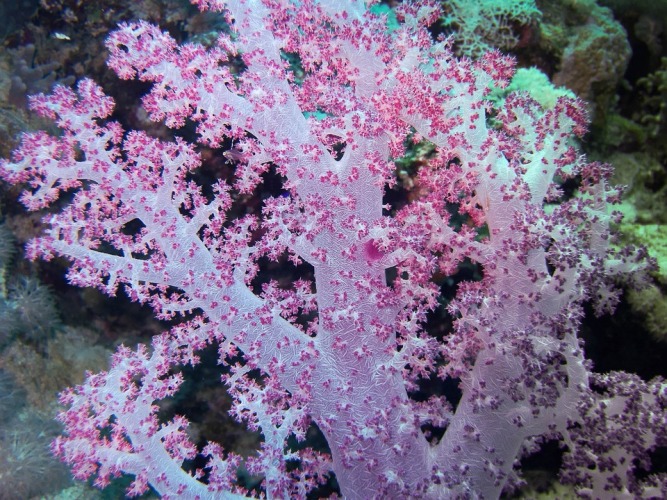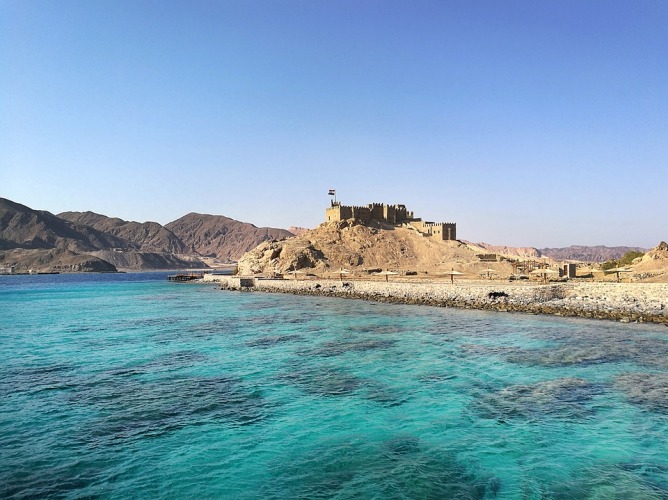The Red Sea is recognized to be the most northern tropical sea that covers about 169,1000 square miles.
Technically, the Red Sea is a seawater inlet of the Indian Ocean and one of the most heavily traversed waterways due to its strategic location as a critical conduit for the world’s economy.
There are more than 1,000 volcanic islands and amazing coral reefs in the Red Sea.
The Red Sea is known for its shallow shelves and the amazing marine creatures that inhabit the coral reefs, of which there are more than 1,200 fish species.
The maximum depth of the Black Sea is 3,040 meters or more than 9,973 feet.
The Red Sea is located between the continents of Asia and Africa, with a northern Suez Canal connection to the Mediterranean Sea.
It is bounded by desert and arid land areas.
Six countries border the Red Sea, including Yemen and Saudi Arabia, Egypt, Sudan, Djibouti, and Eritrea.
The Red Sea’s climate is impacted by the north and southeasterly monsoon seasons.
There is little rain and occasion dust storms from the desert, which keeps the temperature so warm that the Red Sea is recognized as one of the globe’s warmest seas.
The Red Sea’s lack of rain and high level of evaporation creates the Red Sea’s high salinity.
Experts estimate that the salinity in the north part of the Red Sea is 41%, with a 36% salinity on the southern side of the Red Sea.
Contents
So… Are There Sharks in the Red Sea?
Yes, the Red Sea is home to sharks.
In fact, the Red Sea is a preferred recreational shark diving location, popularized about 70 years ago by Jacques -Yves Cousteau.
Much of the tourism in and around the Red Sea is related to water, which includes various snorkeling and dives to its reefs, shipwrecks, or to catch a sighting of this marvelous marine creature.

The Red Sea offers amazing colorful coral reefs, unexplored shipwrecks, and impressive marine wildlife, including year-round shark sightings and encounters.
The following are the sharks found in the Red Sea.
The Grey Reef Shark
The Grey Reef Shark is a shy shark with a maximum of about six feet.
The Grey Reef is stocky and easy to spot due to its dark grey band along the tail’s edge and a white tip of the dorsal fin.
This shark prefers the reef walls, which is why they are often spotted by beginner divers in the area’s popular dive sites all year-round.
The Hammerhead Shark
It is hard to miss this unique, timid shark with scalloped hammerheads.
Easily identified by their uniquely shaped head, scalloped hammerheads are among the Red Sea’s most fascinating shark species.
The Hammerhead Shark is quite graceful for an oceanic predator who is easily scared off by any noise.
They are often encountered when diving in the early morning and the northern Red Sea from July until September or in the southern Red Sea from May until July.
The Oceanic Whitetip Shark
This shark is one of the most dynamic marine animals inhabiting the Red Sea.
The Oceanic Whitetip Shark is curious and opportunistic, so be sure to follow the safety instructions given by diving guides.
If safety measures are followed, an encounter with this incredibly powerful shark can be quite the adventure.
The Tiger Shark
As one of the most elusive and rarest sharks in the Red Sea, the Tiger Shark primarily inhabits the open waters of the ocean but can be seen in the Red Sea.
The Whale Shark
For a few months each year, certain locations along Egypt’s border with the Red Sea become a Whale Shark hotspot.
The Whale Shark feeds on plankton as they have no teeth.
Their favorite food is plankton, and they are often seen cruising the surface of the Red Sea.
The Leopard Shark
This shark is technically known as the Zebra Shark but is most known as the Leopard Shark.
Leopard Sharks are nocturnal bottom-dwellers and are often seen resting on a sandbar or reef and sleeping during the daylight hours.
Night divers can find them free-swimming or eating crustaceans and mollusks.
Leopard Sharks are skittish, so approach slowly.
The Thresher Shark
The Thresher Shark is elusive and shy and most often seen in the early morning.
However, the Red Sea is known for Thresher Shark sightings on a regular basis.
The Thresher has large eyes for hunting in the dark ocean depths, and it stuns its prey using its tail as a whip.

Is it Safe to Swim in the Red Sea?
The reality is sharks rarely attack humans because, as opportunistic predators, these marine animals prefer to feast on fish, seals, and sea lions rather than humans, who are not a part of the shark’s natural diet.
While there are several hundred shark species, only a small fraction of them attack people.
And even then, they attack due to provocation or because they feel threatened or endangered.
Note that unless a shark is behaving aggressively, there is no real caution required.
But if it circles or makes sudden movements, make a fast getaway without turning your back on the shark.
Avoid sharp movements as the shark may perceive this as aggression.
Interesting Shark Facts in the Red Sea
Most shark sightings occur on 10% of dives.
Sharks are fascinating creatures.
They have no bones; only a skeleton made up of cartilage.
The Whale Shark is a vegetarian (and thus, harmless to humans) and only eats algae and plankton.
Divers can safely swim with and around a Whale Shark.
It is important to respect the fact that you are a guest in the sharks’ habitat.
This means, as a guest, you should show humility and respect.
Sharks can eat upwards of 10% of their body weight each week – typically in one or two large meals.
They digest their food between the shark’s meals, and they do not eat again until fully digested.
Sharks live primarily in saltwater locations.
However, certain shark species have adapted to freshwater conditions.
Freshwater tends to be a more hostile environment for a shark because the lack of saline impacts their ability to stay afloat (buoyancy).
Sharks who have not adapted will likely sink and die in a freshwater environment.
Shark species are characterized contingent on the surface temperature of the water they inhabit.
They are included in three categories:
- Polar or Arctic Sharks are those that inhabit frigid waters near or at the polar ice caps. The Dogfish Shark exemplified a type of polar shark.
- As their name suggests, Tropical Sharks are found swimming in warm water, like the waters near or on the equator. The Great Hammerhead with impressive 360-degree vision is an example of a tropical shark.
- Temperate Sharks tend to live in both cold and warm water, migrating for food or mating, as needed. Larger temperate sharks, including the Great White Shark, can find their way to tropical waters.
Further, several freshwater sharks exist in the world.
Consider these examples:
- Speartooth Sharks – which are also known as river sharks, have a wide head, flat snout, with a streamlined body that can reach up to 8.5 feet. The Speartooth Shark is native to freshwater areas in the countries of Papua New Guinea and Northern Australia. The Speartooth Shark has approximately 29 rows of each lower and upper jaw.
- Ganges Shark – is a river shark and home in India. They reach 6.5 feet and spend much of their time on the river bottom.
- The Greenland Shark – this shark can reach 21 feet and is known to have the longest shark lifespan – living between 250 to 500 years!
- Bull Shark – the Bull Shark, has less salt in their bodies which makes a freshwater environment more hospitable. They are strong and considered the most dangerous of freshwater sharks. The Bull Shark prefers to swim in shallow waters, often near unsuspecting swimmers.
- The Pondicherry Shark – this is among the rarest of sharks seen in India and Sri Lanka. Their ability to tolerate freshwater is unknown because so little is known of this shark variety.
- Borneo River Shark – the Borneo River Shark is ranked among the rarest of freshwater sharks. They are small, measuring no more than a couple of feet.

3 Safety Tips for Swimming in Shark-infested Waters
Most people are surprised to learn that shark attacks on a global basis are much rarer than believed to be.
There were only 129 shark attacks reported globally in 2020.
When swimming in potential shark-infested waters, it is prudent to follow safety guides, as follows:
- Avoid swimming in open water during sunset, sunrise, or nighttime. Sharks tend to feed at these times of day, and therefore, a shark would likely be active and looking for food.
- Do not fish with a harpoon where there may be sharks. This movement in the water might attract a shark, especially if fishing in open water.
- Do not attempt to feed the shark or take its picture. This simple act is dangerous and may change a shark’s behavior and lead to a shark attack.
Summary
About 71% of Earth’s surface is covered by water.
The Red Sea is about 1,180 miles long and 186 miles at the widest point.
These countries share a border with the Red Sea – Saudi Arabia, Yemen, Egypt, Israel, Jordan, Sudan, Eritrea, and Djibouti.
Much of the tourism in and around the Red Sea is related to water, which includes various snorkeling and dives to its reefs, shipwrecks, or to catch a sighting of the shark – marvelous marine creature.
These sharks are the most commonly encountered in the Red Sea, which is, in fact, a preferred shark diving location:
- The Grey Reef Shark
- The Hammerhead Shark
- The Oceanic Whitetip Shark
- The Tiger Shark
- The Whale Shark
- The Leopard Shark
- The Thresher Shark
Sources
- https://www.britannica.com/place/Indian-Ocean
- https://en.wikipedia.org/wiki/Red_Sea
- https://en.climate-data.org/africa/egypt/red-sea-governorate-1656/
- https://www.usgs.gov/special-topics/water-science-school/science/saline-water-and-salinity
- https://en.wikipedia.org/wiki/Jacques_Cousteau
- https://www.worldatlas.com/seas/red-sea.html
- https://www.frontiersin.org/articles/10.3389/fmars.2020.00090/full
- https://www.sharks.org/grey-reef-shark-carcharhinus-amblyrhynchos
- https://www.fisheries.noaa.gov/species/oceanic-whitetip-shark
- https://a-z-animals.com/blog/discover-6-freshwater-shark-species/
- https://www.floridamuseum.ufl.edu/shark-attacks/yearly-worldwide-summary/
- https://www.egypttoday.com/Article/6/11746/Red-Sea-has-lowest-rate-of-shark-attacks-–how
- https://a-z-animals.com/blog/discover-6-freshwater-shark-species/
Frequently Asked Questions
Which country that borders the Red Sea claims to have the lowest rate of shark attacks?
According to Egypt’s Environment Ministry, the Ain El-Sokhna area of the Red Sea is free of sharks, with the lowest rate of shark attacks.
How long have sharks inhabited Earth’s waterways?
Sharks have been swimming in the waters of Earth for more than 400 million years – arriving even before the dinosaur age.
How long can a shark potentially live?
The Greenland Shark, the largest in freshwater, can live for 250 to 500 years.
The shark is generally considered mature when they reach about 150 years of age.
How often do sharks replace their teeth?
A shark will generally replace their teeth every eight days or so.











